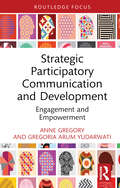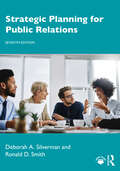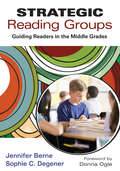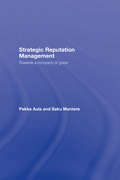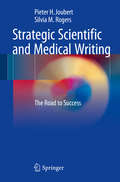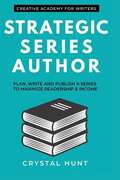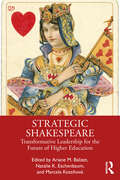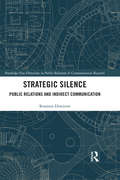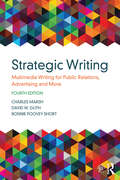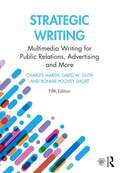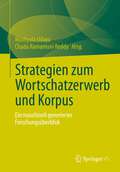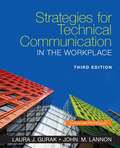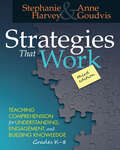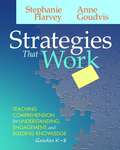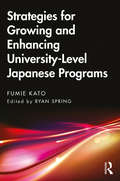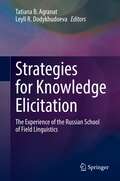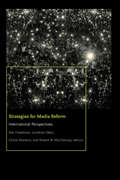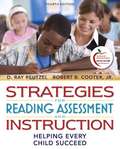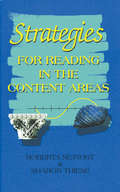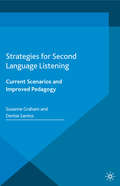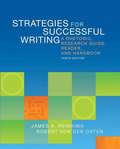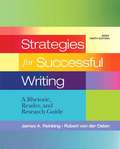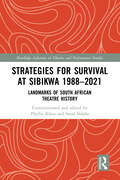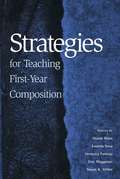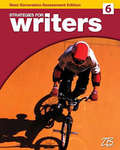- Table View
- List View
Strategic Participatory Communication and Development: Engagement and Empowerment
by Anne Gregory Gregoria Arum YudarwatiThere has been a recent shift in the nature of public engagement from a culture of paternalism and control towards a public-centred approach involving collaboration and co-creation. This book draws on public relations and development communication insights to build a new community engagement model for public sector organisations who wish to engage with rural communities in developing countries. This theoretical model also offers a practical framework for Government in particular to engage with and empower rural communities as they adopt and exploit infrastructure developments. The outcome is mutual benefit.By examining in detail how Government communicates with rural communities on renewable energy infrastructure projects in Indonesia, and underpinned by empirical research with those communities, this new participatory framework has been developed. It envisages progressive empowerment of rural communities as Government encourages active engagement on the installation and exploitation of renewable energy. This entails encouraging communities to determine for themselves their uses of sustainable energy sources and to take ownership of a co-determined future. In so doing, the Government itself is more likely to achieve its own renewable energy commitments.Research-based and combining theory with practice, this thought-provoking book will be welcomed by strategic communication and public relations scholars and practitioners alike.
Strategic Planning for Public Relations
by Ronald D. Smith Deborah A. SilvermanThe seventh edition of Strategic Planning for Public Relations maintains its status as a leading text to guide students in developing successful public relations campaigns.Deborah Silverman and Ronald Smith bring their experience as instructors and public relations professionals to the book, providing clear, step-by-step guidance on how to plan and implement strategic communications campaigns. This new edition includes diverse examples of current cases along with classic cases that stand the test of time. It includes new “Ethics Minutes” scenarios in each step, a new research step, and examples of award-winning public relations campaigns. It also significantly increases information on social media and features a reformatting of the tactics step into four separate parts based on the PESO model (paid media, earned media, shared media, and owned media).As a leader in teaching public relations strategy, this text is ideal for students in upper division undergraduate and graduate courses in public relations strategy and campaigns.Complementing the book are online resources for both students and instructors. For students: step overviews, useful links to professional organizations and resources, checklists for the ten steps in the planning process, and two sample campaigns. For instructors: an instructors’ manual, PowerPoint slides, sample syllabi, a critique evaluation worksheet, and checklists for the ten steps in the planning process. For these online resources, please visit www.routledge.com/9781032391168 .
Strategic Reading Groups: Guiding Readers in the Middle Grades
by Jennifer I. Berne Sophie C. DegenerDifferentiated reading instruction: An effective model for the middle grades Strategic grouping can transform reading instruction in the middle grades from a hit-or-miss learning experience to a targeted, responsive one. This book features a practical and field-tested model for small-group differentiated reading instruction in Grades 4–8. The authors offer a clear, detailed discussion of how to position this instruction inside middle school language arts or reading classrooms and simple, effective strategies for classroom management, groupings, and assessment. This text explains how to: Balance brief strategic reading lessons with whole-class work Structure and guide reading groups consistently Assess students before and during reading groups Cue students and gauge understanding as they read
Strategic Reputation Management: Towards A Company of Good
by Pekka Aula Saku MantereStrategic Reputation Management examines the ways in which organizations achieve "goodness" through reputation, reputation management and reputation strategies. It presents a contemporary model of strategic reputation management, helping organizations and stakeholders to analyze the business environment as a communicative field of symbols and meanings in which the organization is built or destroyed. Authors Pekka Aula and Saku Mantere introduce the eight generic reputation strategies, through which organizations can organize their stakeholder relationships in various ways. They illustrate their arguments using real-world examples and studies, from the Finnish Ski Association to Philip Morris International.This book serves as required reading in advanced courses covering public relations practice, advanced topics in PR, corporate communication, management, and marketing. Professionals working in PR, business, management and marketing will also find much of interest in this volume.
Strategic Scientific and Medical Writing
by Silvia M. Rogers Pieter H. JoubertA document may be based on accurate medical and scientific information, follow guidelines precisely, and be well written in clear and correct language, but may still fail to achieve its objectives. The strategic approach described in this book will help you to turn good medical and scientific writing into successful writing. It describes clearly and concisely how to identify the target audience and the desired outcome, and how to construct key messages for a wide spectrum of documents. Irrespective of your level of expertise and your seniority in the pharmaceutical, regulatory, or academic environment, this book is an essential addition to your supporting library. The authors share with you many years of combined experience in the pharmaceutical and academic environment and in the writing of successful outcome-driven documents.
Strategic Series Author: Plan, Write and Publish a Series to Maximize Readership and Income (Creative Academy Guides for Writers Series)
by Crystal HuntWriting series can be a great way to level up your author career, create a more stable writing income, and create a devoted fanbase. It's also challenging, and can be overwhelming if you're not prepared. Series authors need to consider many things that standalone title authors don't have to worry about. And everything is exponentially more complex once you're tackling more than one book! You might be wondering: What kind of series should I write? Which details do I need to keep track of? How much advance planning should I do? Is publishing strategy different for a series vs standalone titles? How can I get the most bang for my buck in marketing and promotion Experienced series author Crystal Hunt will help you answer all these questions and more with this combination strategy manual and exercises that will get you applying what you've learned to your own series project. Whether you're a seasoned series author, or just starting to explore your options and thinking a series might be a good next step for you, this book can help you write and publish your series smarter from ideas through publication and promotion! This is the third book in the Creative Academy Guides for Writers series. Be sure to check out the rest of the guides for writers in this series.
Strategic Shakespeare: Transformative Leadership for the Future of Higher Education
by Marcela Kostihová Natalie K. Eschenbaum Ariane M. BalizetStrategic Shakespeare demonstrates the value of humanities-trained scholars as leaders in higher education. It features contributions from Renaissance and Shakespearean scholars in leadership roles in North American higher education, who collectively aim to leverage traditional assumptions about Shakespeare in the service of a more inclusive and sustainable academy.Making a powerful case for the liberal arts, the contributors demonstrate ways in which training in the humanities creates a baseline of skills in collaboration, deep listening, tolerance for ambiguity, and a range of positionalities. They also illustrate an astute understanding of disparate data sets, persuasive storytelling, and a commitment to liberal arts education. As this innovative collection showcases, these skills are crucial in the current climate, as higher education struggles with declining enrolments, decreasing budgets, growing public distrust, and (often) hostile legislative oversight. Additionally, the skills help us navigate a rapidly shifting landscape of learning in the aftermath of the COVID-19 pandemic and entry of generative artificial intelligence (AI) to the public sphere. The collection presents theoretical arguments, case studies, personal narratives, and practical advice related to how humanities-trained scholars have led and must continue to lead the academy through transformative change.Strategic Shakespeare is an essential tool for anyone interested in learning from university leaders who have made good things happen on their campuses, in their communities, and in the profession. It celebrates and foregrounds the core adaptive skills that humanities scholars bring to the table, showcasing their unique predisposition for successful academic leadership during a time of unprecedented change.
Strategic Silence: Public Relations and Indirect Communication (Routledge New Directions in PR & Communication Research)
by Roumen DimitrovMainstream public relations overvalues noise, sound and voice in public communication. But how can we explain that while practitioners use silence on a daily basis, academics have widely remained quiet on the subject? Why is silence habitually famed as inherently bad and unethical? Silence is neither separate from nor the opposite of communication. The inclusion of silence on a par with speech and non-verbal means is a vital element of any communication strategy; it opens it up for a new, complex and more reflective understanding of strategic silence as indirect communication. Drawing on a number of disciplines that see in silence what public relations academics have not yet, this book reveals forms of silence to inform public relations solutions in practice and theory. How do we manage silence? How can strategic silence increase the capacity of public relations as a change agent? Using a format of multiple short chapters and practice examples, this is the first book that discusses the concept of strategic silence, and its consequences for PR theory and practice. Applying silence to communication cases and issues in global societies, it will be of interest to scholars and researchers in public relations, strategic communications and communication studies.
Strategic Writing: Multimedia Writing for Public Relations, Advertising and More
by Charles Marsh David W. Guth Bonnie Poovey ShortIn its fourth edition, Strategic Writing emphasizes the goal-oriented mission of high-quality public relations and media writing with clear, concise instructions for more than 40 types of documents. This multidisciplinary text covers writing for public relations, advertising, sales and marketing, and business communication. In addition, it includes concise chapters on topics such as diversity, ethics and the legal aspects of strategic writing. Featuring a spiral binding, examples for each document and a user-friendly "recipe" approach, Strategic Writing is ideal for undergraduate PR or advertising writing classes that take an interdisciplinary approach. This new edition devotes new attention throughout to social media and writing in the digital realm, and features new and updated online resources for students and instructors.
Strategic Writing: Multimedia Writing for Public Relations, Advertising and More
by Charles Marsh David W. Guth Bonnie Poovey ShortThis practical, multidisciplinary text teaches high-quality public relations and media writing with clear, concise instructions for more than 40 types of documents. <p><p>Strategic Writing takes a reader-friendly "recipe" approach to writing in public relations, advertising, sales and marketing, and other business communication contexts, illustrated with examples of each type of document. With concise chapters on topics such as ethical and legal aspects of strategic writing, including diversity and inclusion, this thoroughly updated fifth edition also includes additional document samples and coverage of writing for various social media platforms. Packed with pedagogical resources, Strategic Writing offers instructors a complete, ready-to-use course. <p><p>It is an essential and adaptable textbook for undergraduate courses in public relations, advertising and strategic communication writing, particularly those that take a multidisciplinary and multimedia approach. <p><p>Strategic Writing is ideally suited for online courses. In addition to syllabi for both online and traditional courses, the instructor’s manual includes Tips for Teaching Strategic Writing Online. Those tips include easy guidelines for converting the book’s PowerPoint slides to videos with voiceovers for online lectures. The book’s recipe-with-examples approach enhances student self-instruction, particularly when combined with the companion website’s sample assignments and grading rubrics for every document.
Strategien zum Wortschatzerwerb und Korpus: Ein maschinell generierter Forschungsüberblick
by Muthyala Udaya Chada Ramamuni ReddyDieses Buch untersucht den Bereich der ESL/EFL-Wortschatz- und Korpusstudien aus fünf umfassenden Perspektiven: Erwerb, Strategien, IKT, Korpus und aktuelle Praktiken. Die fünf Abschnitte des Buches sind so gruppiert, dass eine ausgewogene Abdeckung der Beschreibungen, wie Vokabeln erworben werden, und der verschiedenen Strategien, die von Lernenden und Lehrenden eingesetzt werden, um den Wortschatz zu beherrschen, erreicht wird. Einer der Abschnitte befasst sich mit dem Einfluss der Informations- und Kommunikationstechnologien auf das Lernen und neue Lehrmethoden. Der Abschnitt über das Lehren und Lernen von Korpus und Wortschatz enthält Zusammenfassungen darüber, wie Korpora die Sprache der Lernenden sein können und wie sie sich direkt auf den Unterricht auswirken. Der letzte Abschnitt über aktuelle Praktiken und Forschung beleuchtet die von Lehrenden und Forschenden angewandten Praktiken bei der Entwicklung des Themas Wortschatz. Dieses Buch ist eine wertvolle Ressource für Forschende, Lehrende und Sprachmittler*innen, die sich für die Natur des Wortschatzes im ESL/EFL-Lehr- und Lernkontext interessieren.
Strategies For Technical Communication In The Workplace (Third Edition)
by Laura J. Gurak John M. LannonBased on the acclaimed Technical Communication by Lannon and Gurak, Strategies for Technical Communication in the Workplace, Third Edition prepares students for workplace writing through a clear and concise writing style, useful checklists, practical applications, numerous sample documents, and coverage of technology and global issues. <P><P>The third edition addresses changing technology in the workplace with a complete chapter on social media, updated examples, and sample documents. This brief and affordable text is accessible to students of all writing levels.
Strategies That Work: Teaching Comprehension for Engagement, Understanding, and Building Knowledge, Grades K-8
by Stephanie Harvey Anne GoudvisSince the first publication of Strategies That Work , numerous new books on reading comprehension have been published and more educators than ever are teaching comprehension. In this third edition of their groundbreaking book, authors Stephanie Harvey and Anne Goudvis bring you Strategies That Work: Teaching Comprehension for Understanding, Engagement, and Building Knowledge. This new edition is organized around three section: Part I: Starting with the Foundation of Meaning, these chapters provide readers with a solid introduction to reading comprehension instruction, including principles that guide practice, suggestions for text selection, and a review of recent research Part II: Part II contains lessons to put these principles into practices for all areas of reading comprehension Part III: This section shows you how to integrate comprehension instruction across the curriculum and the school day, with a focus on science and social studies. In addition, this new version includes updated bibliographies, including the popular Great Books for Teaching Content, online resources, and fully revised chapters focusing on digital reading, strategies for integrating comprehension and technology, and comprehension across the curriculum. Harvey and Goudvis tackle close reading, close listening, text complexity, and critical thinking and demonstrate how your students can build knowledge through thinking-intensive reading and learning. This third edition is a must-have resource for a generation of new teachers – and a welcome refresher for those with dog-eared copies of this timeless guide to reading comprehension.
Strategies That Work: Teaching Comprehension for Understanding, Engagement, and Building Knowledge
by Stephanie Harvey; Anne GoudvisStrategies That Work, more than a million teachers have benefited from Steph and Anne's practical advice on creating classrooms that are incubators for deep thought. This third edition is a must-have resource for a generation of new teachers--and a welcome refresher for those with dog-eared copies of this timeless guide to teaching comprehension.
Strategies for Growing and Enhancing University-Level Japanese Programs
by Fumie KatoStrategies for Growing and Enhancing University-Level Japanese Programs offers foreign language program managers and directors, as well as teachers of less commonly taught languages, the insights and proven practical actions they can take to enhance and grow their language programs. Using the Japanese program at UNC Charlotte as the primary case study, author Fumie Kato provides step-by-step instructions on how she grew the Japanese program there from 133 students per semester in 2002 to 515 students per semester in 2017; from a program with just one full-time professor and one part-time faculty member, to a faculty of seven full-time and three part-time members. While Japanese is the example used in the book, the principles can be applied by anyone managing foreign language/less commonly taught language programs who wishes to expand their program and raise their students’ success rates. The book is therefore of interest to instructors, coordinators and directors of foreign language education programs throughout the world.
Strategies for Knowledge Elicitation: The Experience of the Russian School of Field Linguistics
by Tatiana B. Agranat Leyli R. DodykhudoevaThis volume provides an overview of experimental methods, approaches, and techniques used by field linguists of the Russian school, and highlights the fieldwork experience of Russian scholars working in regions with a range of languages that differ genetically, typologically, and in the degree of their preservation.The collection presents language and sociolinguistic data relating to fieldwork in diverse languages: Uralic, Altaic, Paleo-Siberian, Yeniseian, Indo-European Iranian, Vietic, Kra-Day, and Mayan languages, as well as pidgin.The authors highlight the fieldwork techniques they use, and the principles underlying them.The volume’s multidisciplinary approach covers linguistic, ethnolinguistic, sociolinguistic, educational, and ethnocultural issues. The authors explore problems associated with the study of minority languages and indicate diverse and creative techniques for data elicitation. Close collaboration with speakers lies at the core of their approach. The collection presents strategies for eliciting systems of knowledge from mother-tongue speakers, triggering linguistic self-awareness, and providing semantic and morphosyntactic context for their languages.This publication is intended for academics, and for specialists in the field of linguistics and minority and indigenous languages. It will also benefit students as a guide to field research, as well as language activists, interested in documenting and preserving their mother tongue.
Strategies for Media Reform: International Perspectives (Donald McGannon Communication Research Center's Everett C. Parker Book Series)
by Jonathan A. Obar Cheryl Martens Robert W. McChesneyMedia reform plays an increasingly important role in the struggle for social justice. As battles are fought over the future of investigative journalism, media ownership, spectrum management, speech rights, broadband access, network neutrality, the surveillance apparatus, and digital literacy, what effective strategies can be used in the pursuit of effective media reform?Prepared by thirty-three scholars and activists from more than twenty-five countries, Strategies for Media Reform focuses on theorizing media democratization and evaluating specific projects for media reform. This edited collection of articles offers readers the opportunity to reflect on the prospects for and challenges facing campaigns for media reform and gathers significant examples of theory, advocacy, and activism from multinational perspectives.
Strategies for Reading Assessment and Instruction: Helping Every Child Succeed (4th Edition)
by D. Ray Reutzel Robert B. CooterThis best-selling book is a ready-reference for teachers of reading, a highly popular core text for reading diagnosis and assessment courses, and an ideal guide for ongoing professional development workshops. The unique format of the book, with its IF/THEN Strategy Guides that help readers quickly match student needs to research-proven strategies, make it a quick, effective, "point-of-teaching" resource of up to date information, strategies, and suggestions. In Strategies for Reading Assessment and Instruction Readers can quickly turn to current information on evidence-based assessment and instruction and find ways to assess, teach, and organize for effective and comprehensive reading instruction.
Strategies for Reading in the Content Areas
by Roberta L. Sejnost Sharon M. ThieseFormerly a SkyLight publication.Strategies for Reading in the Content Areas-excerpted from Reading and Writing Across Content Areas-describes the reading process and suggests strategies that can be used before, during, and after reading. Teachers will find examples for science, social studies, mathematics, and health. This handy booklet is a great, easy-to-access resource for content area teachers!
Strategies for Second Language Listening: Current Scenarios and Improved Pedagogy
by Suzanne Graham Denise SantosThis book seeks to help teachers teach listening in a more principled way by presenting what is known from research, exploring teachers' beliefs and practices, examining textbook materials, and offering practical activities for improving second language listening.
Strategies for Successful Writing: A Rhetoric, Research Guide, Reader, and Handbook (Tenth Edition)
by James A. Reinking Robert von der OstenStrategies for Successful Writing keeps instruction brief and to-the-point so that students spend less time reading about writing and more time writing. Instruction delivered through extensive examples helps students see what different strategies look like when applied in real texts.
Strategies for Successful Writing: A Rhetoric, Research Guide, and Reader (Brief Edition, 9th Edition)
by James A. Reinking Robert von der OstenThe ninth edition of Strategies for Successful Writing: A Rhetoric, Research Guide, and Reader is a comprehensive textbook that offers ample material for a full-year composition course.
Strategies for Survival at SIBIKWA 1988 – 2021: Landmarks of South African Theatre History (Routledge Advances in Theatre & Performance Studies)
by Phyllis Klotz Smal NdabaThis book provides an engaging and contextualised insight into a South African township-based arts centre that has survived the vicissitudes of steady militarisation in townships during some of the worst years of apartheid as well as the exhilaration of a new democratic policy while attempting to circumnavigate different policies and funding dispensations. Sibikwa provides arts centres across the world and especially those in decolonising countries with strategies for survival in tumultuous times. This multi-disciplinary book maps and co-ordinates wider historical, political, and social contextual concerns and events with matters specific to a community-based east of Johannesburg and provides an exploration and analysis by experts of authentic theatre-making and performance, dance, indigenous music, arts in education and NGO governance. It has contemporary significance and raises important questions regarding inclusivity and transformation, the function and future of arts centres, community-based applied arts practices, creativity, and international partnerships. This study will be of great interest to students and scholars in theatre and performance, indigenous music, dance, and South African history.
Strategies for Teaching First-Year Composition
by Duane Roen Veronica Pantoja Lauren Yena Susan K. Miller Eric WaggonerThis book presents 93 essays that offer guidance, reassurance, and commentary on the many activities leading up to and surrounding classroom instruction in first-year composition. Essays in the book are written by instructors who teach in community colleges, liberal arts colleges, state university systems, and research institutions.
Strategies for Writers (6th grade) (Next Generation Assessment Edition)
by Rebecca Bowers Sipe L. Crawford"Features a rubrics-based instruction and a writing process with emphasis on prewriting and revising. Grammar is taught in conjunction with writing, so students learn how grammar is best applied to writing." (teacher's edition p.T2).
